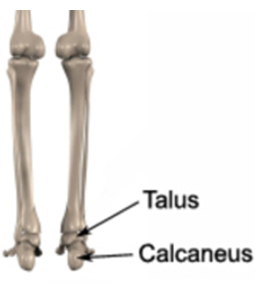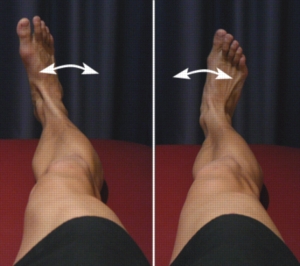What is Sinus Tarsi Syndrome?
Sinus Tarsi Syndrome
The sinus tarsi is a small cavity located on the outside of the ankle between the talus and calcaneus bones.
Publish date : Sunday 27 April 2014 03:06

The sinus tarsi is a small cavity located on the outside of the ankle between the talus and calcaneus bones (figures 1 and 2). This cavity contains numerous anatomical structures including ligaments and joint capsule. These structures may be injured following an ankle sprain or due to the repetitive strain associated with an excessively pronated (flat) foot. When this occurs, the condition is known as sinus tarsi syndrome.
Cause of sinus tarsi syndrome
Sinus tarsi syndrome usually occurs following an ankle sprain or due to the repetitive strain associated with walking or running on an excessively pronated (flat) foot.
Signs and symptoms of sinus tarsi syndrome
Patients with sinus tarsi syndrome typically experience pain over the outside of the ankle. There may also be swelling and tenderness in the region. Symptoms are typically worse in the morning and may present as pain and stiffness that slowly improves as the patient warms up. Symptoms may also be aggravated during walking or running especially on slopes or uneven surfaces.

Treatment for sinus tarsi syndrome
The vast majority of patients with sinus tarsi syndrome heal well with an appropriate physiotherapy program. The success rate of the physiotherapy program is largely dictated by patient compliance. One of the key components is that the patient rests sufficiently from ANY activity that increases their pain until they are symptom free (crutches may be required). This allows the body to begin the healing process in the absence of further tissue damage. Once the patient can perform these activities pain free, a gradual return to these activities is indicated provided there is no increase in symptoms.
Ignoring symptoms or adopting a 'no pain, no gain' attitude
Treatment for sinus tarsi syndrome
Following the R.I.C.E. Regime with regular icing and anti-inflammatory medication may help to significantly reduce inflammation in the initial phase of this condition. A graduated flexibility, balance and strengthening program under direction from a physiotherapist is vital to ensure an optimal outcome.
In the final stages of rehabilitation, a gradual return to activity or sport should occur under guidance from the treating practitioner and provided symptoms do not increase.
Contributing factors to the development of sinus tarsi syndrome
There are several factors which can predispose patients to developing this condition. These need to be assessed and corrected with direction from a physiotherapist and may include:
- poor flexibility
- inappropriate training
- poor foot biomechanics
- inappropriate footwear
- muscle weakness
Physiotherapy for sinus tarsi syndrome
Physiotherapy treatment is vital to hasten the healing process, ensure an optimal outcome and reduce the likelihood of injury recurrence in all patients with this condition. Treatment may comprise:
- soft tissue massage
- electrotherapy (e.g. ultrasound)
- anti-inflammatory advice
- joint mobilization
- taping
- bracing
- the use of crutches
- ice or heat treatment
- exercises to improve strength, flexibility and balance
- education
- activity modification advice
- biomechanical correction
- footwear advice
- a gradual return to activity program
Prognosis of sinus
Most patients with this condition heal well with an appropriate physiotherapy program
Most patients with this condition heal well with an appropriate physiotherapy program. This, however, can be a lengthy process and may take several months in patients who have had their condition for a long period of time. Minor cases of this condition that are identified and treated early can usually settle within a few weeks. Early physiotherapy treatment is vital to hasten recovery and ensure an optimal outcome.
Other Intervention for sinus tarsi syndrome
Despite appropriate physiotherapy management, a small percentage of patients with this condition do not improve adequately. When this occurs the treating physiotherapist or doctor can advise on the best course of management. This may involve further investigation such as an X-ray, Ultrasound, CT scan or MRI, corticosteroid injection, pharmaceutical intervention or a review by a specialist who can advise on any procedures that may be appropriate to improve the condition. A review with a podiatrist for the prescription of orthotics and appropriate footwear advice may also be indicated.
The exercises for this common problem
The following exercises are commonly prescribed to patients with this condition. You should discuss the suitability of these exercises with your physiotherapist prior to beginning them. Generally, they should be performed 3 times daily and only provided they do not cause or increase symptoms.
Foot and Ankle Up and Down
Move your foot and ankle up and down as far as possible and comfortable without pain (figure 3). Repeat 10 - 20 times provided there is no increase in symptoms.

Foot and Ankle In and Out
Move your foot and ankle in and out as far as possible and comfortable without pain (figure 4). Repeat 10 -20 times provided there is no increase in symptoms.

Lunge Stretch
With your hands against the wall, place your leg to be stretched in front of you as demonstrated (figure 5). Keep your heel down. Gently move your knee forward over your toes as far as possible and comfortable without pain. Hold for 5 seconds and repeat 10 times at a mild to moderate stretch provided there is no increase in symptoms.
